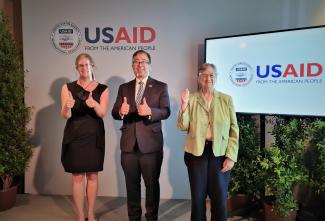For Immediate Release
Press Release
From mobilizing over $7 billion in renewable energy investments to facilitating nearly 10,000 megawatts of renewable energy capacity (enough to power roughly 8 million homes), the United States Government’s Clean Power Asia program is making Southeast Asia cleaner and greener.
On April 2, Chargé d’Affaires at the U.S. Embassy Michael Heath gave remarks at the Renewable Energy Symposium and Electric Vehicle Challenge, the capstone of Clean Power Asia, a USAID funded regional program. “President Biden is placing climate change at the center of U.S. foreign policy,” he said. “Our USAID [United States Agency for International Development] Clean Power Asia program made huge investments in clean power and is projected to help the region avoid 30 million tons of carbon dioxide emissions over the next 15 years,” he continued.
Since 2016, the USAID Clean Power Asia program has worked with governments and the private sector across Southeast Asia to encourage power sector investments in environmentally friendly, grid-connected renewable energy sources. USAID and the Embassy have announced plans to continue these efforts through a new program called the Southeast Asia Smart Power Program that will promote utility modernization, energy efficiency, advanced technologies, and regional power trade, and will improve local air quality and mitigate global climate change.
“As we celebrate USAID’s achievements in energy in Thailand and across the region, we also look to the future and partnerships that will continue to strengthen energy investments in the region, facilitating the transition to a clean energy future and enhanced regional energy security,” said Chargé d’Affaires Heath.
Dana Kenney, Chief of Party for USAID Clean Power Asia, said, “USAID Clean Power Asia collaborated with local and international partners to share lessons learned and best practices to overcome policy and technical barriers that have limited the deployment of clean energy technologies to support increasing demands for electricity, which are set to double by 2040. Even amidst the COVID-19 global pandemic, we have achieved our goals through our four activity areas of improving power sector planning, fostering supportive policy frameworks, mobilizing finance and investment, and promoting enhanced regional collaboration.”
From 2016 to 2021, USAID’s $16.3 million Clean Power Asia program also:
- Developed and published financial models for utility-scale and rooftop solar, wind, and biomass power, which were downloaded over 3,000 times and used to help renewable energy project developers identify critical factors that impacted project profitability and bankability.
- Collaborated with Thailand’s Office of the Energy Regulatory Commission to develop regulations and technical standards to ensure the safety and performance of battery energy storage systems. This important step towards more battery deployments will increase the penetration of renewable energy, reduce pollution from fossil fuels, and help develop an electric vehicle infrastructure, supporting Thailand’s transition towards a carbon-neutral country.
- Worked with the Government of Laos to support the country’s first-ever solar auction, from auction design to submission of the final auction announcement package. This auction will not only offset polluting emissions, but also improve fair and transparent power project procurement and promote energy security and independence for Laos.
About USAID Clean Power Asia
For the past five years, USAID Clean Power Asia has been working with Lower Mekong countries and other Southeast Asian nations to encourage power sector investments in environmentally friendly, clean energy sources, focusing on incorporating renewable energy into planning, promoting smart incentives, building an enabling environment for renewable energy policies, and mobilizing finance. USAID Clean Power Asia collaborated with diverse stakeholders, partners, and regional organizations to share lessons learned and best practices across Southeast Asia to accelerate the regional transition to a high performing, low carbon power sector.
For more information, please visit www.usaidcleanpowerasia.org.

